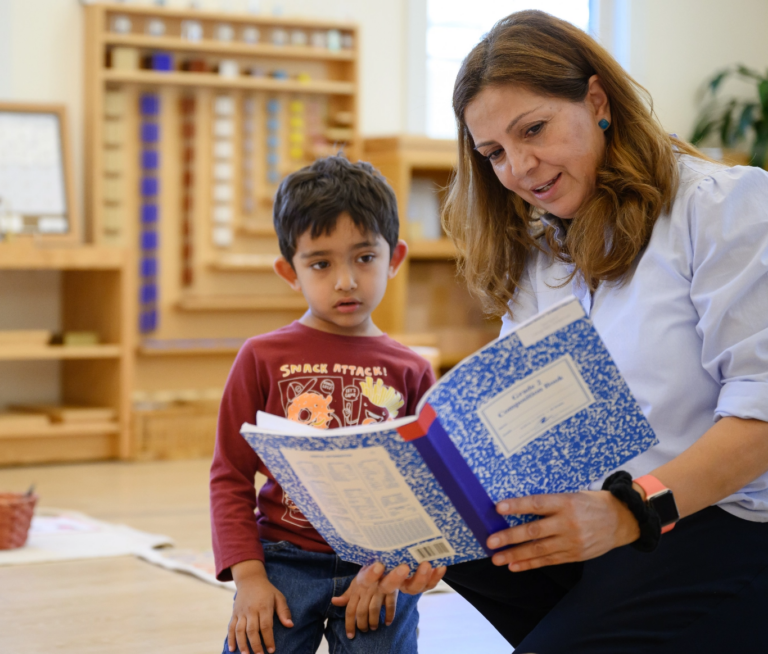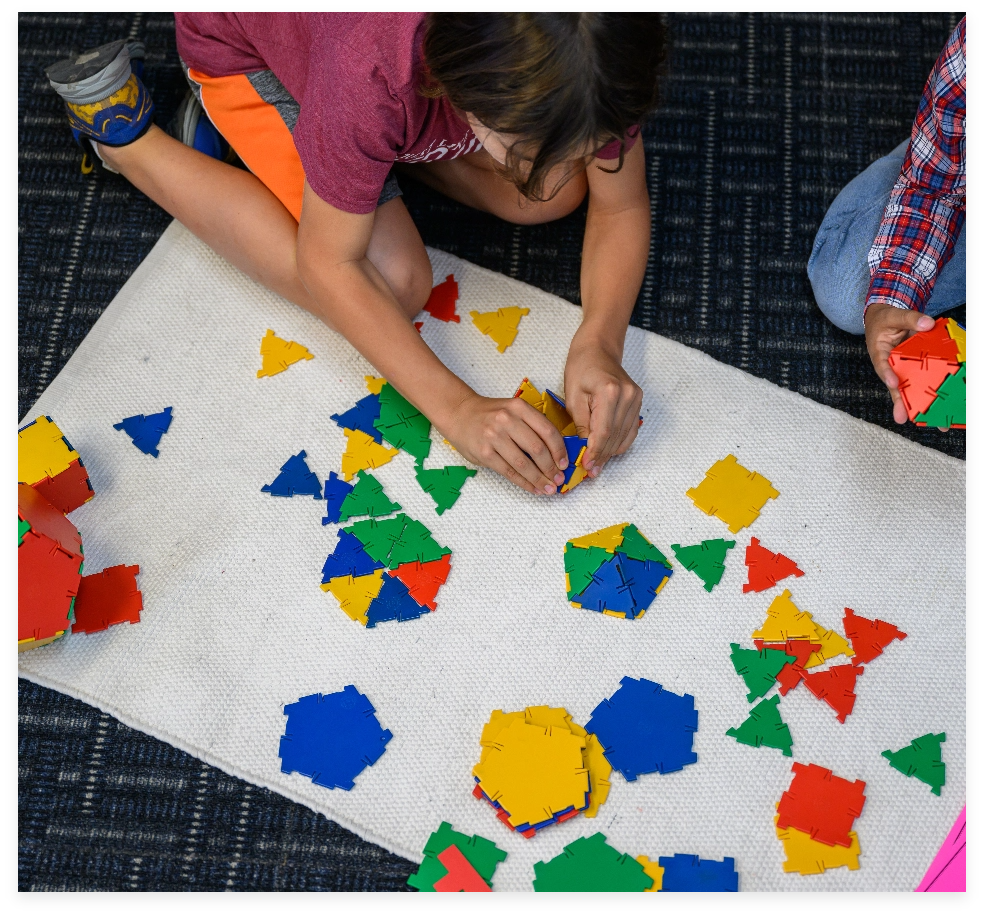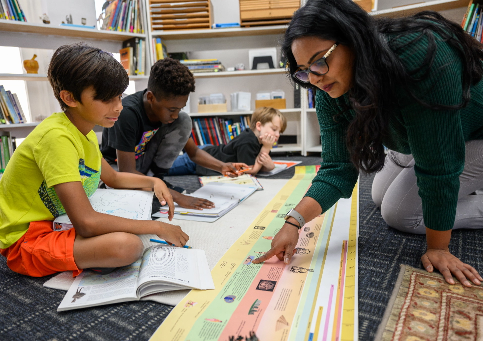
5 Core Components of Montessori Education
Discover the elements critical to high-fidelity implementation of Montessori, and the language and terminology that coincide. The American Montessori Society aims to remain loyal to the original method Dr. Maria Montessori developed while adapting and innovating alongside the demands of modern society.
Trained Montessori Teachers
A qualified Montessori teacher supports children’s natural development by observing their interests and abilities and introducing developmentally appropriate lessons and materials. Trained in Montessori theory and practice, these teachers skillfully use materials, guide students, and create a supportive learning environment. AMS recognizes credentials from AMS, the Association Montessori Internationale (AMI), and accredited Montessori teacher education programs.
The Multi-Age Classroom
In Montessori schools, multi-age groupings allow younger children to learn from older peers and face new challenges through observation, while older children reinforce their learning by teaching and developing leadership skills. This setup fosters cooperation and reflects real-world interactions across ages. Montessori classrooms are organized by developmental stages, though some schools adjust groupings for state regulations. Typical age ranges are:
- Infants: Birth – 18 months
- Toddlers: 15 months – 3 years
- Early Childhood: 2.5 – 6 years
- Lower Elementary: 6 – 9 years
- Upper Elementary: 9 – 12 years (or combined Lower and Upper Elementary, 6 – 12 years)
- Secondary: 12 – 15 years and 15 – 18 years (or 12 – 14, 14 – 16, and 16 – 18 years)

Using Montessori Materials
Each carefully crafted material focuses on a single skill or concept and follows a logical sequence, aiding children in developing a deeper, abstract understanding.
Child-Directed Work
Montessori education encourages children to select meaningful, challenging work that sparks their interest, fostering engagement and intrinsic motivation. The classroom design supports this with calm, uncluttered spaces for both individual and group activities, promoting curiosity. Children are free to move and explore, while teachers guide their learning and ensure a respectful, orderly environment.
Uninterrupted Work Periods
In Montessori classrooms, the “uninterrupted work period” lets students work at their own pace, respecting their individual learning styles. During this time, students select and complete tasks without interruption, building coordination, concentration, and independence. The cycle involves choosing an activity, engaging with it, cleaning up, and selecting a new task. Teachers support and monitor students, providing individual and small-group lessons. AMS recommends the following work periods for each program level:
- Infant & Toddler: Minimum 2 hours daily, including mealtime, snacks, hygiene, and nap/rest.
- Early Childhood: Minimum 2 hours daily, 4 days a week; 3 hours optimal, 5 days a week.
- Elementary: Minimum 2 hours daily, 4 days a week; 3 hours optimal, 5 days a week.
- Secondary: Minimum 2 hours daily for core subjects.

Montessori Terminology
Dr. Maria Montessori introduced many terms and concepts to describe child development and learning, which are still widely used in the Montessori community today. You may come across these terms as you explore the Montessori method.
A B C D E F G H I J K L M N O P Q R S T U V W X Y Z
Absorbent mind – From birth through approximately age 6, the young child experiences a period of intense mental activity that allows her to “absorb” learning from her environment quickly and easily without conscious effort.
Casa dei Bambini – In Italian, “Children’s House,” and the name of Dr. Montessori’s first school.
Children’s House – In many Montessori schools, this is the name of the classroom for children ages 2.5 (or 3) to 6 years; other schools call the classroom for this age group Casa, preschool, primary, or early childhood.
Concrete to abstract – A logical, developmentally appropriate progression that allows the child to develop an abstract understanding of a concept by first encountering it in a concrete form, such as learning the mathematical concept of the decimal system by working with Golden Beads grouped into units, 10s, 100s, and 1,000s.
Control of error – Montessori materials are designed so that the child receives instant feedback about her progress as she works, allowing her to recognize, correct, and learn from an error without adult assistance. Putting control of the activity in the child’s hands strengthens her self-esteem and self-motivation as well as her learning.
Coordination of movement – Refining large- and fine-motor movements is one of the accomplishments of early childhood development, as the child learns to complete tasks independently. The Montessori classroom offers opportunities for children to refine their movements and children are drawn to these activities, especially to those which require exactitude and precision.
Cosmic education – Maria Montessori urged us to give children a “vision of the universe” to help them discover how all of its parts are interconnected and interdependent, and to help them understand their place in society and the world. In Montessori schools, children in Elementary programs (between the ages of 6 – 12) learn about the creation of the universe through stories that integrate the studies of astronomy, chemistry, biology, geography, and history. These lessons help children become aware of their own roles and responsibilities as humans and as members of society, and help them explore their “cosmic task”—their unique, meaningful purpose in the world.
Didactic materials – Didactic meaning “designed or intended to teach,” these are the specially-designed instructional materials—many invented by Maria Montessori—that are a hallmark of all Montessori classrooms.
Directress or guide – Historically, the designation for the lead teacher in a Montessori classroom; some schools still refer to the lead teacher as “directress” or “guide,” while others use the more recognizable term, “teacher.” In Montessori education, the role of the teacher is to guide individual children to purposeful activity based upon her observations of each child’s readiness and interests.
Erdkinder – German for “child of the earth,” this term describes a Montessori learning environment for adolescents ages 12 – 15 that connects them with nature and engages them in purposeful, hands-on work in which they contribute to the community. Erdkinder programs are often referred to as “farm schools.”
Freedom within limits – Montessori classrooms are carefully and thoughtfully designed to encourage children to move about freely and choose their own work, within reasonable limits of appropriate behavior. Those limits are the classroom ground rules, and enable children to exercise their own free will while ensuring that their chosen activities are respectful of others and their environment.
Grace and courtesy – In Montessori schools, children are formally instructed in social skills they will use throughout their lives, for example, saying “please” and “thank you,” interrupting conversations politely, requesting rather than demanding assistance, and greeting guests warmly.
Ground rules – Classroom rules in the Montessori classroom are typically referred to as “ground rules” which dictate appropriate behavior in the classroom. At all age-levels, the ground rules are simple—children are free to work with any material or activity displayed in the environment as long as they use it respectfully. They may not harm the material, themselves, or others.
Mixed-age grouping (or multi-age grouping) – One of the hallmarks of Montessori education is that children of mixed ages work together in the same class. Age groupings are based on the Planes of Development as identified by Dr. Maria Montessori. Multi-age groupings enable younger children to learn from older children and experience new challenges through observation; older children reinforce their learning by teaching concepts they have already mastered, develop leadership skills, and serve as role models. Because each child’s work is individual, children progress at their own pace; there is cooperation rather than competition between the ages. This arrangement mirrors the real world, in which individuals work and socialize with people of all ages and dispositions. Typically, children from 2.5/3 – 6 years of age are grouped together in an Early Childhood classroom. 6 – 9 year olds share the Lower Elementary (grades 1 – 3) and the Upper Elementary is made up of 9 – 12 year olds (grades 4 – 6). At the Secondary level, groupings may be 2- or 3-years. Children from birth – age 3 may be grouped in varying multi-age configurations, and are commonly grouped from birth to 15/18 months (or when mobile) and 15/18 months to age 3.
Nido – “Nest” in Italian, this is a Montessori environment for infants, though not all schools that offer an infant program use this term.
Normalization – A natural developmental process exhibited by a love of work or activity, concentration, self-discipline, and joy in accomplishment. Dr. Montessori observed that children in Montessori programs exhibit normalization through repeated periods of uninterrupted work during which time they work freely and at their own pace on their own chosen activities. A normalized child is a happy, well-adjusted child who exhibits positive social skills in the Montessori classroom.
Planes of development – Four distinct periods of growth, development, and learning identifies by Dr. Maria Montessori that a human being progresses through: ages 0 – 6 (the period of the “absorbent mind”); 6 – 12 (the period of reasoning and abstraction); 12 – 18 (when adolescents construct the “social self,” developing moral values and becoming emotionally independent); and 18 – 24 years (when young adults construct an understanding of the self and seek to know their place in the world).
Practical life – The Montessori term that encompasses “domestic” work to maintain the home and classroom environment; self-care and personal hygiene; and grace and courtesy. Practical life skills are of great interest to young children and form the basis of later abstract learning.
Practical life activities – Young children in Montessori classrooms learn to take care of themselves and their environment through activities such as hand washing, dusting, and mopping. These activities help toddlers and preschool-age children learn to work independently, develop concentration, and prepare for later work with reading and math; older children participate in more advanced activities such as cooking, gardening, operating a business.
Prepared environment – The teacher prepares the environment of the Montessori classroom with carefully selected, aesthetically arranged materials that are presented sequentially to meet the developmental needs of the children using the space. Well-prepared Montessori environments contain appropriately sized furniture, a full complement of Montessori materials, and enough space to allow children to work in peace, alone, or in small or large groups.
Primary classroom – In some Montessori schools, this is a classroom for children ages 3 – 6 years; however, the American Montessori Society uses the term ‘Early Childhood’ and defines the age range as 2.5 – 6 years.
Sensitive period– A critical time during human development when the child is biologically ready and receptive to acquiring a specific skill or ability—such as the use of language or a sense of order—and is therefore particularly sensitive to stimuli that promote the development of that skill. A Montessori teacher prepares the environment to meet the developmental needs of each sensitive period.
Sensorial materials – Work with these materials develops and refines the 5 senses—seeing, hearing, touching, tasting, and smelling—and builds a foundation for speech, writing, and math. Each scientifically designed material isolates a specific quality such as color, size, or shape. This focuses the child’s attention on this one characteristic, and teaches her to sort, classify, order, and develop vocabulary to describe objects she experiences in the world around her.
The 3-period lesson – A 3-step technique for presenting information to the child. In the first—the introduction or naming period—the teacher demonstrates what “this is.” (The teacher might say “This is a mountain” while pointing to it on a 3-dimensional map.) In the second—the association or recognition period—the teacher asks the child to “show” what was just identified (“Show me the mountain”). Finally, in the recall period, the teacher asks the child to name the object (“What is this?” she asks the child, while pointing to the mountain.) Moving from taking in new information, to passive recall, to active identification reinforces the child’s learning and demonstrates her mastery of the concept.
Work – Purposeful activity. Maria Montessori observed that children learn through purposeful activities of their own choosing. Montessori schools call all of the children’s activities “work.” While “work” sounds like a serious endeavor, Dr. Montessori observed that children exhibit joy and experience this purposeful activity as play.
Work cycle – Within the prepared environment of the Montessori classroom, children are taught to complete a work cycle which includes 1) choosing an activity; 2) completing the activity to completion (perhaps repeating the full sequence of the activity multiple times), cleaning up and returning the materials to the proper place; and 3) experiencing a sense of satisfaction to have fully completed the task.